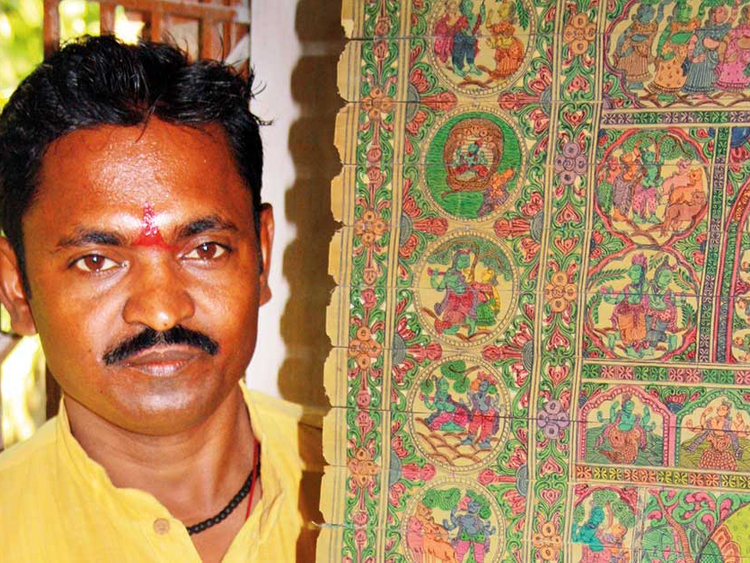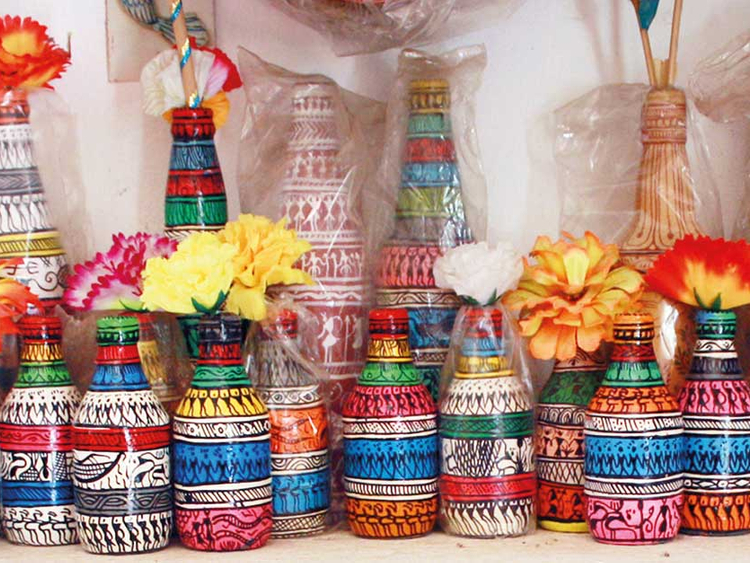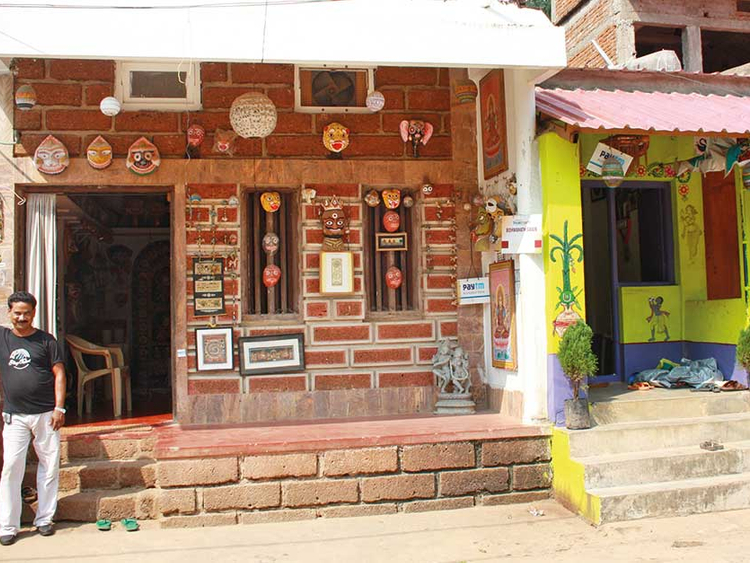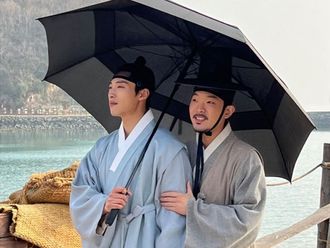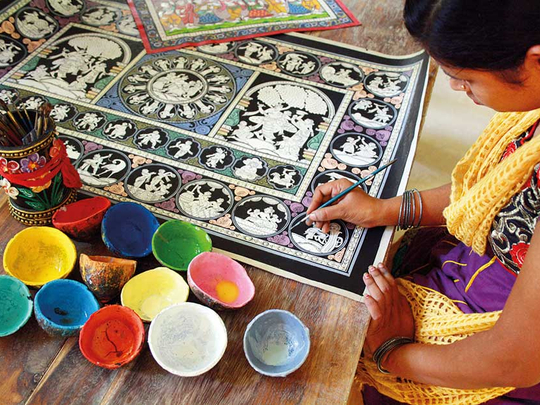
Even as India is gearing up to make its cities smart, Raghurajpur, in Odisha’s Puri district already boasts of a village that has a ‘smart’ tag attached to it. Referred to as the ‘heritage village’, this unique village occupies a prominent position in the cultural map of the country, drawing both national and international tourists who visit the place to enjoy the rich traditions of Odishi arts and crafts at one place.
Raghurajpur provides a glimpse into the world where Pattachitra — the traditional art of painting and carving — is the preferred profession of most families residing here. More than 500 members of the total 145 families are engaged in one craft or the other. Some of them are winners of National Awards.
About 50 km away from Bhubaneswar, Raghurajpur is situated on the southern bank of River Bhargavi, on National Highway 203. The entrance to the village is marked prominently by a signboard flanked by lion sculptures on either side. Surrounded by coconut, palm and mango groves, the scenic beauty of the entire stretch adds to the charm, making it one of its kind tourist destination of the country. The houses are built in two symmetrical rows facing each other and a series of small temples dedicated to local deities occupy the lane between the homes.
Keeping alive the vibrant art and crafts, the skilled villagers have decorated the outer walls of their modest houses by painting them in varied hues including parrot green, bright blue, saturated orange and deep ochre. These are decorated with murals of mythological scenes from the Hindu scriptures — the Ramayana and the Mahabharata. Some adorn variety of pattachitra paintings, etchings and figurines.
Bhaskar Mohapatra, who has practised the art since childhood, says, “I was only four-year-old when I began taking interest in painting. I was very naughty and would not attend school. Instead, I hovered around my father and grandfather while they painted. Seeing no way out, at the age of 10, I was sent to receive training in the traditional art of pattachitra from shilpi guru Jagannath Mohapatra during the 1980s.”
Bhaskar came into the limelight when Prime Minister Narendra Modi chose to gift his pattachitra painting entitled Tree of Life to French president Francois Hollande during his visit to France in 2015. Bhaskar proudly declares, “For us, pattachitra is not merely a profession but a way of life.”
A Lalit Kala Akademi award-winning artist, he has won many accolades for his expertise in palm leaf painting, commonly known as pattachitra in Odisha. His compositions are also created on paper, cloth and canvas.
Giving an insight into the Tree of Life, he said, “It was done using pigments on silk. I was overwhelmed when I found out from a national television channel that [the] prime minister had chosen my painting to gift to the French president. In fact, I had completed this pattachitra in 2014. Tourists and art lovers from France and Belgium had come to our village with a local contact searching for me. They had bought some of my paintings and requested me to draw the Tree of Life. I painted it with multiple roots and branches, much like a banyan tree. The tree is a motif for benevolence. Usually, pattachitra artworks are created using tribal and traditional painting styles. I included a lot of motifs and drew it in a manner that made it look like a tree.”
The choice made by the prime minister from among hundreds of different varieties of traditional art forms that exist in the country itself speaks for the uniqueness of pattachitra. Going into the nuances of this art, Bhaskar explained that pattachitra is a combination of two words patta and chitra. In local parlance, patta means canvas or cloth and chitra means picture — meaning painting on canvas.
Scholars suggest that pattachitra dates back to the 2nd century BCE to the mural art found inside Khandagiri and Udayagiri caves of Bhubaneshwar and in the Ganjam district of Odisha. It is said that the modern day version of pattachitra dates back to the time of construction of Lord Jagannath Temple in 12th century AD and it grew hand-in-hand with the worship of the Hindu deity Lord Jagannath (Lord of the Universe), whose temples abound in the state’s Puri district. The themes depicted in pattachitra are mostly mythological, religious stories and folklore.
While there are other centres of patta paintings in Odisha, the patta painters, known as chitrakars, have made Raghurajpur the most famous for this unique art. “Unlike other Indian villages where youth prefer government or private jobs, our children prefer to join elders in artwork. My family has been involved in this art form for five generations. The fifth generation includes my daughters, who are interested both in pattachitra and tribal paintings. As for myself, other than pattachitra, I do not have any other interest or option to earn a living,” Bhaskar says.
Having produced some of the finest artworks, he provided a glimpse into the techniques and procedures. “The specially prepared cloth is coated with a mixture of gum and chalk and polished before applying natural colours to it. The preparation of canvas for painting involves binding two layers of cotton fabric with a gum prepared from tamarind seeds and thereafter coating it with a white paste made of a powdered limestone and tamarind seeds. This is done to make it stone hard, so that it does not crack. Once it gets dried, the cloth is polished to make it smooth and perfect for painting. The painter sketches the bare outlines of the painting with charcoal or limestone. This is usually done from memory, though decorative motifs like borders and certain geometric forms are copied from pre-cut stencils to save time,” he detailed.
The colours used — white, black, red, yellow, blue and green — are prepared from natural ingredients. White is prepared from powder of conch-shell, black from the soot of oil lamps, red from geru (red oxide stone), yellow from harital stone, blue from indigo and green from leaves. These apart, the leaves of plants, flower petals, fruits, ground rocks and even the urine of domesticated animals contribute to the production of a variety of shades and hues. To ensure fastness of colours, natural gum of a fruit called kaitha is mixed with the colours along with water in coconut shells while painting.
For mass production though, artists now use chemical-based dyes and paints. “However, these do not last long, whereas natural colours can look fresh even after 500 years! The painting may fade, but the colours stay the same,” explains Bhaskar, who has travelled to the US, the UK and several Indian states to take part in exhibitions.
In earlier times, pattachitra was restricted to temple premises. Artists would line up on either side of the Jagannath temple and paint on the spot. By evening they would sell their paintings that solely comprised mythological subjects. But over the years, themes changed. Village atmosphere, jungle scenes and other designs took over and pattachitra began to be displayed on the walls of living rooms and became a collectors’ item. The difference in paintings then and now has also undergone a sea change. Buyers now ask for works that are intricately done. So works that could earlier be accomplished in a day or two, now take weeks to be completed, another artist says.
Devdutt, 36, has been in the profession for three decades. Like many others in the village, he too began painting as a child. “I was fascinated by the paintings but was able to make sense of the works only after I completed my training. Presently, I run a school that provides training to young boys and girls who become accomplished artists, earning and supporting their families.”
Impressed by the work of artisans, the Indian National Trust for Art and Cultural Heritage (Intach) had selected Raghurajpur village to revive the ancient wall painting in 2000. With intervention from other such arts and cultural organisations, the skills of artists and artisans got a boost. And as more artists bagged awards and accolades, officials said, it not only improved the economic standards of the villagers, but efforts were also made to link them to wider markets in India and abroad. As part of the development initiatives, the state government planned to design doors of every house and improve sanitation and other facilities in the village.
However, Devdutt says, “Despite claims made by the government agencies, most of us are yet to see any change. Since there has been no monetary gain, our living conditions remain pathetic. Instead of just promising schemes for the benefit of the artists, the government needs to send emissaries to focus on ground realities and promote the works of those dedicated to the art, rather than people who are bent upon making money by selling their art.”
Janaki and Babita are among scores of students who attend workshops held by Devdutt. Apart from drawing on canvas, the two are keen on producing designs on sarees. “We get orders for four to five sarees a month and that helps us add to the family income,” Babita says.
There are also those, like 26-year-old Deepti whose father is a farmer. “I was keen on studies and began painting seriously only after completing graduation. Seeing most of my friends involved in pattachitra, my interest grew. Today, I am able to interact directly with customers and that has increased the sale of my paintings. I have decided to continue with this art even after I get married.”
Such enthusiasm has added to Raghurajpur becoming a place where every villager is an artist and every house an artist’s studio. It is the first village which has been developed as part of the rural tourism promotion project. Each house has a dedicated front room that serves as a studio-cum-exhibition space and both parents and children feel proud to display their works.
All pattachitra artists follow a similar technique and a similar method of drawing and decoration. But just as no two people’s handwriting is the same, each artist comes up with a product that has its own distinct style. While some focus only on two colours (black and white), others make multi-coloured designs that are much in vogue.
There is an informal division of work as the entire family is engaged in shouldering some of the responsibilities related to paintings. Earlier, women prepared the canvas, boiled the gum and powdered the stones and men worked on the paintings. But as times changed, both men and women became all-rounders, putting their artistic skills on display.
While some artists including Biswanath Swain and Laxmidhar Subudhi proudly put on view the national awards bagged by them for their workmanship, there do exist others who feel that like most Indian folk arts, pattachitra is seeing fewer practitioners. “Unlike us, young people do not have the patience to sit for hours and work painstakingly. So, chitrakars like us prefer to send their children out for education. Later, it is up to them to either take up a job or pursue the family’s art tradition,” Bijoy remarked.
Still, as tourists frequent the village, and sales have been rising, many young girls and women are now training to learn the art of pattachitra, with a considerable number coming from outside the village.
Raghurajpur is also famous for crafts other than pattachitra. Those not involved in this art form produce different varieties of handicrafts including palm leaf engravings. The illustrations are executed on the oblong palm leaf. The pictures are etched in black with cutouts. When these are done for a manuscript, they are bound together with a thread, passing just through the middle of the leaves. Another form is to join the leaves with the help of the thread to form a rectangular or square format. Other interesting items include stone and wood carvings and delicate brushwork on tussar silk. The stories are numerous and ubiquitous, revealed in colourfully painted coconuts, papier-mache toys, masks and painted boxes. Possessing unique beauty and charm, they add colour to Raghurajpur’s lustre.
Nilima Pathak is a journalist based in New Delhi.



